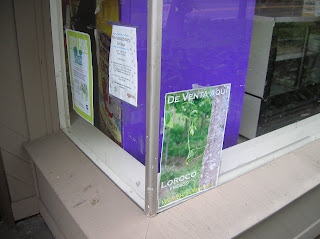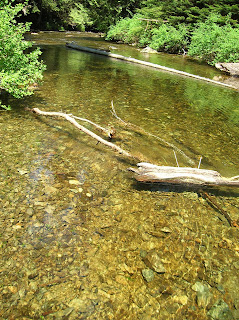Seattle Tours
Some notes on wandering around Seattle and environs.Saturday, June 23, 2007
Block 6 Lot 9, Stander Addition, est. 1907
My friend Pete hosted a party to celebrate the 100th birthday of his house near 27th and Columbia. Pete researched this history of his house, including the names and professions of people who had lived there over the years. He also contacted a woman who lived in the house from 1978-1982 and she came to enjoy the backyard evening. The band June Madrona from Olympia played music.
Here is the June Madrona, twiddling:
Thursday, June 21, 2007
Yogoman's Wild Rumpus
Another trip to Whatcom, aka Bellingham. Highlights:
The oldest brick building in Washington state, c. 1858, built during the brief boom associated with the Fraser River gold rush.
Yogoman selector prepares to warm the turntables. Early-evening hula-hooping in the background. 550 heads came to bounce.
A heron and a seagull fill their gullets down on the bay.
Saturday, June 16, 2007
First Rubus fruits of the year
On 110th near Greenwood, salmonberry (Rubus spectabilis, on left) was ripe and mock orange (Philadelphus lewisii, on right) was in bloom.
Friday, June 15, 2007
Coal to Roberts Bank
Today noted a unit coal train waiting near Pier 86, pointing Canada-wards. I haven’t seen a coal train pass through Seattle in years. It turns out that BNSF is once again bringing Powder River basin coal to the Roberts Bank coal terminal in Vancouver, BC – the largest coal terminal on the west coast of north america. From there, the coal is shipped across the Pacific Ocean.
This train was the object of much excitement on local train fan websites, I later found out. It originates at the Spring Creek mine in Wyoming, then is routed through Sheridan WY, Sandpoint ID, Spokane, Pasco, Vancouver WA, Seattle and on to Vancouver BC.
Below:
This train was the object of much excitement on local train fan websites, I later found out. It originates at the Spring Creek mine in Wyoming, then is routed through Sheridan WY, Sandpoint ID, Spokane, Pasco, Vancouver WA, Seattle and on to Vancouver BC.
Below:
(1) Looking south along tracks near Pier 86. From left, we see an empty BNSF garbage train, the aforementioned coal train, and, farther to the right, grain cars. Amgen pedestrian bridge in the background, and Pier 86 grain terminal farther back.
(2) North from Amgen pedestrian bridge. Coal train in middle-right of photo.
(3) Some crows also found the train interesting.
(2) North from Amgen pedestrian bridge. Coal train in middle-right of photo.
(3) Some crows also found the train interesting.
Thursday, June 14, 2007
Erratic
Went and visited big rocks in Seattle, in their resting places as found in 1851.
Big Rock in Wedgewood. The street grid goes around it. When this land was platted it was just too big to move. It is about 20 feet tall.
Big Rock in Wedgewood. The street grid goes around it. When this land was platted it was just too big to move. It is about 20 feet tall.
By 100th St. entrance to Carkeek, just across from CarkeekPlaza (nee Art's Plaza). Small compared to the other.
Four Mile Rock off Magnolia -- hard to figure the scale from this picture, i hope to go back at low tide. It is as big as Big Rock, if not bigger.
Monday, June 11, 2007
Going nowhere
On the way to the University District, stopped by Foster Island to look at the lake and the mountains.
Later saw the hardcore band Same-sex Dictator at Camp Nowhere next to the freeway in the UD. I was one of the few people not in the band or living in the house. But that's fine.
Wednesday, June 06, 2007
Sos loroco
At the Salvadoran Bakery in White Center, you can get loroco shipped from Metapan, a northwestern department of El Salvador. Loroco (Fernaldia pandurata) is a plant in the dogbane family with an edible greenish-white flower. It grows in El Salvador and the people there use the flower in soup and as a garnish in other dishes. Most importantly it can be used as a filling in pupusas, the national food of El Salvador, typically in combination with cheese. It is not available year round, so when it comes 'round the people want it, apparently here in Seattle too. (The sign was taken down within a couple weeks).
Loroco is also an alternative way to say 'loco' in El Salvador, so "sos loroco" means "you're crazy."
Tuesday, June 05, 2007
Longfellow's head
Staying in High Point, I decided to check out the Delridge/Longfellow valley. Across the street from Westwood Village shopping center is the Roxhill bog, the headwaters of Longfellow Creek. This has been the site of restoration work in recent years. Likely planted by loving neighbors, we see here red indian paintbrush (Castilleja sp.), yellow monkey flowers (Mimulus sp.) and purple lupines (Lupinus sp.):
While it is known as the Roxhill bog, it is not truly a bog. Not to split sedge leaves, but it is more of a fen than a bog. This is because of the dominance of sedges and not sphagnum moss and other bog-obligates like Labrador tea. True bogs can not exist if urban drainage is arriving at the area, due to excessive inputs of cations like calcium and magnesium, which lower the acidity of the water in the bog -- leading to sedge invasion. Here we can see the sedges in the wetland, with the Westwood Village shopping area to the north (downslope). It is also interesting to note that it was possible to walk in the "bog" since it was quite dry; its original hydrology has also been altered by the installation of street drainage networks, which affects plant communities as well.
Westwood Village shopping center (now renamed Westwood Town Center) near White Center serves immigrants, more comfy working class folk and gentrifying white newbies alike. It is not at all like Westwood Village in Los Angeles. They renamed it in the last five years or so when the redeveloped it.
A landscape feature was created to represent the stream that came through here at one point. It is not actually connected to the stream or bog. Longfellow Creek is a very sick urban waterway -- many of the salmon that go upstream to spawn in the autumn die before they lay eggs, due to something in the water.
Sunday, June 03, 2007
Traipse on Alki
I will have more later on the social phenomenon of Alki on a sunny day, but to be brief: a favorable day on June 3 brought out just about everyone in Seattle. BBQs, volleyball and frisbee, cars with the bounce, locals, tourists, rich poor and all colors, and over a dozen languages (spanish, italian, english (various forms), chinese, japanese, vietnamese, tagalog, amharic, arabic, russian, etc etc) amidst the salty Alki breeze. Around 7 pm the clouds rolled in and it poured, thus beginning a wet and unsettled June weather pattern.
Below, the view to the west from the end of the beach, showing the imminent weather and the sun taking leave.
Saturday, June 02, 2007
Sunday Lake
Five days ago Jonah and I could not find Sunday Lake, yet we yearned to contemplate those still waters, and so made another trip up the North Fork of the Snoqualmie River. The lake is surrounded by some old growth that pokes out from the Alpine Lake Wilderness -- a peninsula of old forest surrounded by clearcuts. We walked through a bog, got lost a couple times, and then found the lake. We saw flowers: pacific bleeding heart, false lily-of-the-valley, salmonberry, thimbleberry, bunchberry, speedwell, red columbine, strawberry, wood violet, large-leaved avens, labrador tea, siberian miner's lettuce, tall bluebells, arnica and various saxifragaceous forbs, among others.
Pictures, in order: (1) Span bridge over the northfork, with old growth timbers; (2) Sunday Lake, elevation 1900 feet; (3) outlet of Sunday Lake into Sunday Creek; (4) Red columbine, Aquilegia formosa (Ranunculaceae)
Pictures, in order: (1) Span bridge over the northfork, with old growth timbers; (2) Sunday Lake, elevation 1900 feet; (3) outlet of Sunday Lake into Sunday Creek; (4) Red columbine, Aquilegia formosa (Ranunculaceae)

Friday, June 01, 2007
A search for birch
In the postings of April 19 and April 26, I mentioned how I collected and made medicine from cottonwood and alder trees. My next target was birch. I was lumping birch trees with alder and cottonwood for several reasons: botanically, because birch and alder are in the same family (Betulaceae); ecologically, because they are found in similar environments, namely wet and disturbed ones; and medicinally, because they all have analgesic properties. I could have made willow the third of the triad for basically the same reasons, but I already have a ton of willow tincture left from years ago.
Specifically, with birch it is the bark that is used as an analgesic, for headaches and arthritis. The leaves have other properties, but I only harvested bark. The bark can be made into a tincture or put into rubbing alcohol for a liniment. Or, a decoction can be made of the bark, and can be used externally or internally. The bark’s properties come from the presence of betulin, betulinic acid and methyl salicylate.
In Seattle there are no natural/wild stands of native birch. Most birch you see are (european) white birch; there are also some landscaped paper birch. The paper birch is native to this region, but it turns out that the southern end of its range is just north of here. So to look for it, I took public transit back to Bellingham and rode around the countryside near Gooseberry Point and the Lummi Reservation. This is a low-lying area influenced by the Nooksack River, which drains into the sea here. Cottonwood and alder were ubiquitous. There were some huge monotypic patches of cottonwood, all the same age, which likely generated after a large flood in 1990.
Specifically, with birch it is the bark that is used as an analgesic, for headaches and arthritis. The leaves have other properties, but I only harvested bark. The bark can be made into a tincture or put into rubbing alcohol for a liniment. Or, a decoction can be made of the bark, and can be used externally or internally. The bark’s properties come from the presence of betulin, betulinic acid and methyl salicylate.
In Seattle there are no natural/wild stands of native birch. Most birch you see are (european) white birch; there are also some landscaped paper birch. The paper birch is native to this region, but it turns out that the southern end of its range is just north of here. So to look for it, I took public transit back to Bellingham and rode around the countryside near Gooseberry Point and the Lummi Reservation. This is a low-lying area influenced by the Nooksack River, which drains into the sea here. Cottonwood and alder were ubiquitous. There were some huge monotypic patches of cottonwood, all the same age, which likely generated after a large flood in 1990.
The birch was difficult to find: here or there I encountered an individual or three. While the bark was peeling, it was more exfoliating than peeling in large strips like i remembered. It was also much darker bark than I remebered, though for certain it was birch.
Turns out that what I was seeing was a different species of birch -- water birch, Betula occidentalis and not papery Betula papyrifera. Or it could have been a naturally occuring hybrid of the two, since it is reportedly common for them to interbreed.
Below you see the trunk bark and the leaves of water birch.
Archives
April 2007 May 2007 June 2007 October 2007 February 2008 March 2008
Subscribe to Comments [Atom]
























